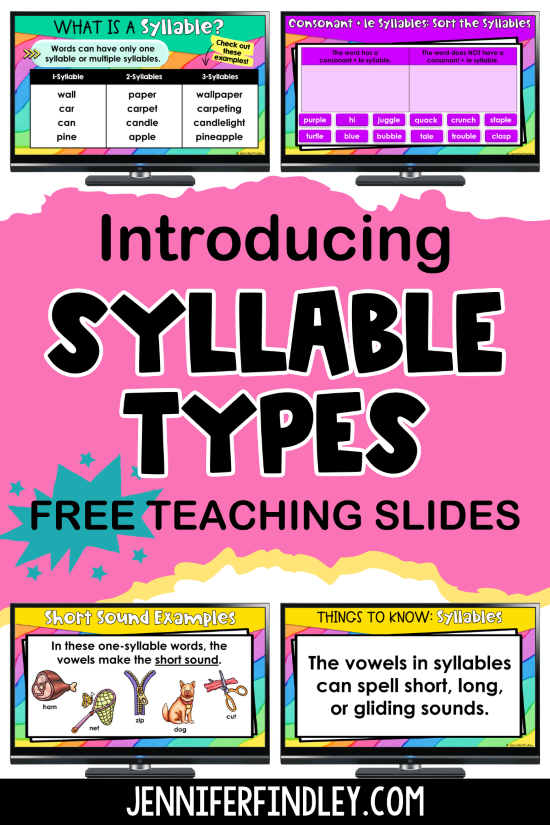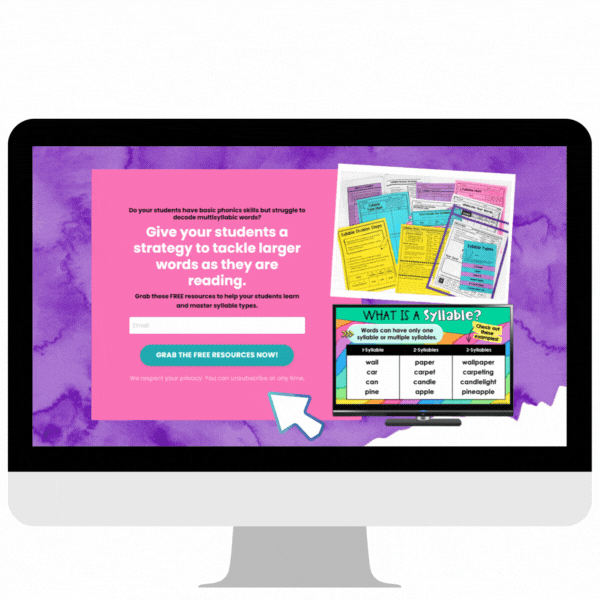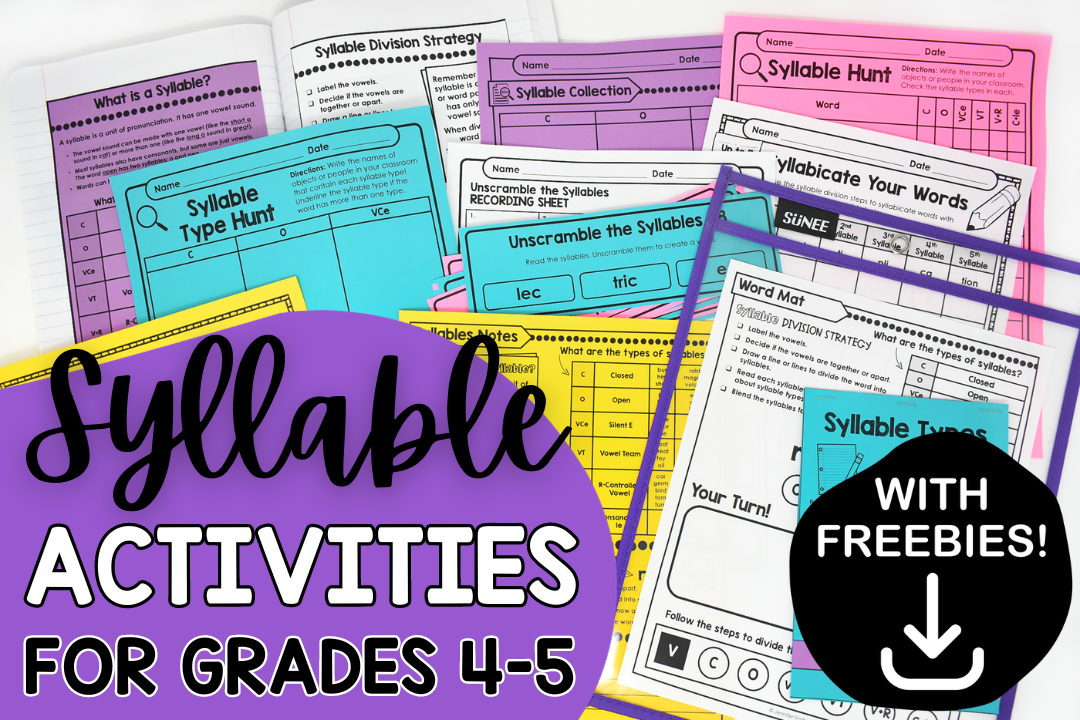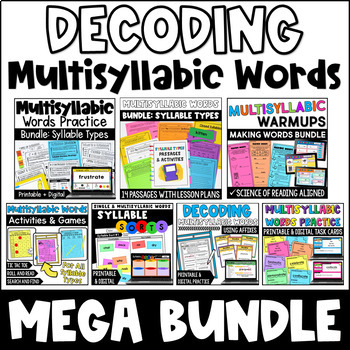Some random teaching memories stick with you as a teacher. One of those memories for me was when a reading interventionist told me that my struggling students could benefit from syllable type instruction. It stuck with me because, in that moment, I had no idea what she was talking about and definitely no idea how to teach my students this or why it was even important.
Several years and lots of research and education later, I finally have the skills and understanding that I lacked then. To help you (if you were anything like me), I wanted to write this blog post explaining how to introduce and start syllable type instruction with your students and give you access to a free set of teaching slides to walk you through the entire process.

Introducing Syllable Types: Overview
When introducing and teaching the syllable types, I follow a three-step process:
Step 1: Review syllable basics
Step 2: Review more details about syllables and specifically the characteristics of vowels that may be found within those syllables (short vowels, long vowels, vowel teams, etc).
Step 3: Introduce and teach the syllable types. This step is broken down further by each syllable type with lots of opportunities for practice. Depending on your students and your timeframe for instruction, this step can take up to a month.
At each step in the process, I am monitoring and assessing student understanding and progress before moving on.
Introducing Syllable Types: A Closer Look
Now let’s look closer at the three steps. Each step in the 3-step sequence corresponds with a set of teaching slides that you can use for your syllable type introduction and instruction.
Step 1: Review syllable basics (Let’s Learn About Syllables)
First, start with a quick review of what a syllable is and how to identify or count syllables in words. Practice counting syllables in a variety of words.
Step 2: Review more details about syllables and the characteristics of vowels that may be found within those syllables (More Things About Syllables)
Once you have reviewed syllables and students can count them in spoken words, move into reviewing more details about syllables and the vowels found within them. Also, at this point, note any gaps in students’ understanding.
Here are the specific syllable and vowel skills and concepts I review (each one is included in the teaching slides for this step or part).
- Vowel sounds can be short, long, or gliding sounds.
- Vowels can work with other vowels to spell one sound.
- Vowels can work with consonants to spell one sound.
- The letter “y” can spell the vowel sound in a syllable.
- Vowels can be controlled by the letter r which distorts the sound.
- Syllables can consist of single vowels.
These skills are introduced, then modeled with one-syllable words, and then finally with multisyllabic words.
In addition to the slides that review the skills in one-syllable and multi-syllabic words, there are also quick practice opportunities via moveable, interactive sorts.
Step 3: Introduce and Teach the Syllable Types
After the review and practice of these key syllable and vowel skills, you are ready to dive into the specific syllable types.
To do this, I like to use a discovery approach paired with explicit instruction and practice.
For each syllable type, here is a sequence to follow for introducing them:
- Using a discovery approach, introduce the syllable type.
- Explicitly teach the characteristics of that syllable type.
- Identify examples and non-examples.
- Analyze multisyllabic words with the syllable type (and other previously taught syllable types).
The slides below show the discovery approach for introducing open syllables.
After the discovery approach, there is a recap slide to explicitly teach the characteristics and to ensure there are no misunderstandings.
The slide below shows the interactive moveable components that are included for students to identify examples and non-examples of the syllable type, which is the third step.
Finally, the students are ready to analyze and syllabicate multisyllabic words that include the syllable type (and previously introduced syllable types).
As you can see from the slides below, when practicing open syllables, the students also review closed syllables (the syllable type taught prior to open syllables).
Here are some guidelines to keep in mind when introducing syllable types. The free teaching slides follow these guidelines.
- Teach the syllable types in a specific sequence beginning with the most common type (closed) and then proceeding from there to the other types.
- As you introduce new syllable types, use words that review previously taught syllable types so the learning is cumulative.
Here is the sequence I use (and that the teaching slides follow):
- Closed Syllables
- Open Syllables
- VCe Syllables (Silent E)
- Vowel Team Syllables
- R-Controlled Syllables
- C + le Syllables
Introducing Syllable Types: Access the Free Teaching Slides Here
To get the FREE introducing syllable types teaching slides, click here or on the GIF shown below. You will be redirected to a new page where you can enter your email for instant access to the teaching slides and more resources to help your syllable type instruction.
Syllable Types: What’s Next?
You want to ensure that you are incorporating a variety of activities for practice and review. To see more details about the types of activities you can use (and grab free ones), click here or on the image below.
Need Syllable Type Activities?
Click on the image below to grab my Mega Bundle of Teaching Six Syllable Types Activities. It includes all of the other resources shown on this post.
This discounted mega bundle includes:
1. Practice to explicitly teach each syllable type (and games and activities to reinforce them)
2. Sorts to sort syllables and words by syllable type
3. Syllable warmups to start your reading lessons (small group or whole group)
4. Multisyllabic word task cards to help students practice flexing sounds (set for variability)
5. Syllable type passages WITH lessons


















I like like to teach the prefixes, roots, base words and suffixes for my forth grade students. I love using the posters you have created. However, there are some that are not there that are part of my curriculum. Is there a way to add my own base word, root, prefix or suffix to the colorful posters, so I can keep them all the same. FOr example: root- vent (to come) I want to add this one but still want it to match the other root poster that you have provided.